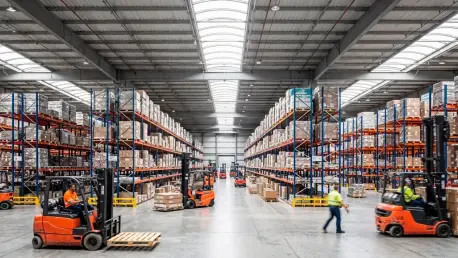I’m thrilled to sit down with Rohit Laila, a seasoned veteran in the logistics industry with decades of experience spanning supply chain management and delivery. Rohit’s passion for technology and innovation has positioned him as a thought leader in optimizing warehouse operations. Today, we’ll dive into his insights on cutting-edge loading solutions, the impact of innovative equipment on efficiency, and how adaptability plays a key role in meeting high-volume demands in modern logistics.
How did you first become involved in the logistics sector, and what drives your passion for innovation in this field?
I stumbled into logistics almost by accident early in my career, but I quickly realized how much I enjoyed solving the complex puzzles of supply chain and delivery. What keeps me hooked is the constant evolution—there’s always a new challenge or technology that can transform how we move goods. I’m passionate about finding smarter, faster, and more sustainable ways to streamline operations, whether it’s through new equipment or rethinking workflows. It’s about making a real impact for businesses and their customers.
Can you share an overview of the types of logistics and packing solutions your team focuses on, and what makes them stand out?
We specialize in third-party logistics and contract packing, which means we handle everything from warehousing to customized packaging for our clients. Our goal is to take the operational burden off their shoulders so they can focus on their core business. What sets us apart is our flexibility—we tailor solutions to fit specific needs, whether it’s managing high-volume orders or adapting to unique product requirements. It’s all about creating efficiency and trust with every partnership.
What inspired the decision to invest in a cutting-edge yard lift solution at one of your facilities?
We were facing a new high-volume contract that demanded fast and efficient loading and unloading of various vehicle types, including double-deck trailers. Traditional methods just weren’t cutting it in terms of speed and safety. After researching options, we saw that a vehicle-to-ground yard lift offered the perfect balance of versatility and efficiency. It was a strategic move to ensure we could meet client expectations without missing a beat.
How has this new equipment changed the way your team handles loading and unloading operations?
It’s been a game-changer. The lift allows us to load directly from the warehouse floor to vehicles of different heights, which eliminates a lot of manual handling and reduces risk. Compared to older methods, it’s much quicker—we can process a full articulated vehicle in just a few cycles. The efficiency gains have been noticeable, especially in how many shipments we can turn around in a day. It’s streamlined our workflow significantly.
I understand the installation of this lift was incredibly fast. How did such a quick setup affect your day-to-day operations?
Honestly, it was a pleasant surprise. The entire installation took just a few days, and there was almost no disruption to our ongoing work. We didn’t have to halt operations or deal with long downtimes, which is critical in our industry. Our team adapted quickly with minimal training, and we were up and running before we knew it. That speed allowed us to focus on fulfilling orders rather than wrestling with setup issues.
With the lift’s impressive capacity, how has it influenced your daily workflow and throughput?
The capacity to handle heavy loads and multiple pallets at once has been a huge boost. We’re able to process more vehicles in less time, which directly translates to higher throughput. It’s also helped us optimize scheduling—there’s less congestion in the yard, and we can turn vehicles around faster. Plus, the extra capacity gives us confidence to take on larger orders without worrying about bottlenecks.
The lift was set up in a temporary structure, which sounds unique. Can you tell us more about how that worked and the benefits it brought?
Setting it up in a temporary space was a bit unconventional, but it showcased the equipment’s versatility. There were some minor challenges, like ensuring stability and weatherproofing, but nothing insurmountable. The real benefit is the flexibility it offers—we didn’t need to commit to permanent infrastructure, which is ideal for a business like ours where needs can shift rapidly. It’s a reminder that innovative solutions can adapt to almost any environment if designed well.
One of the standout aspects of this solution is its cost-effectiveness. Can you elaborate on the financial advantages you’ve seen by avoiding major construction?
Absolutely. Traditional loading setups often require expensive civil works, like building permanent docks, which can cost a fortune and take months. With this lift, we bypassed all of that. The upfront investment was much lower, and we saved on long-term maintenance costs too. There were even unexpected savings, like not having to redirect resources during a lengthy construction phase. It’s proof that you don’t need to break the bank to achieve top-tier efficiency.
How has this equipment supported your ability to meet the demands of high-volume contracts?
It’s been instrumental. The specific contract we took on required us to handle a massive volume of goods six days a week, often with tight deadlines. The lift’s speed and capacity mean we can keep up with that pace without sacrificing accuracy or safety. It’s also given us the confidence to scale up and take on similar projects, knowing we have the tools to deliver. It’s become a cornerstone of our operation for big contracts.
Looking ahead, what’s your forecast for the future of loading and logistics technology in the industry?
I think we’re on the cusp of some exciting changes. Automation and smart technology are going to play an even bigger role—think IoT-enabled equipment that predicts maintenance needs or optimizes loading patterns in real time. Sustainability will also drive innovation, with more focus on energy-efficient systems and reducing carbon footprints. The challenge will be balancing cost with these advancements, but I’m optimistic we’ll see solutions that make logistics faster, greener, and more accessible to businesses of all sizes.









